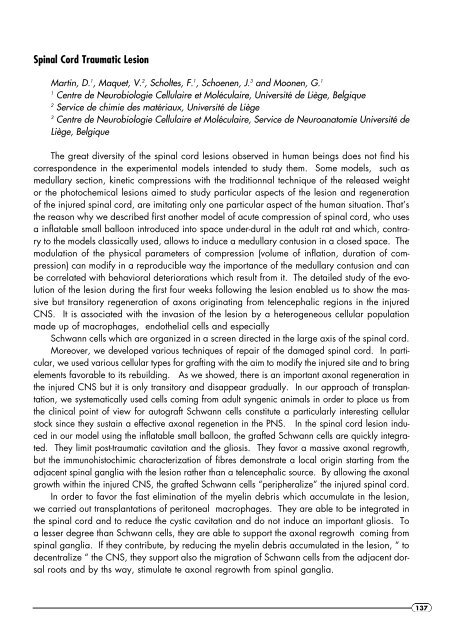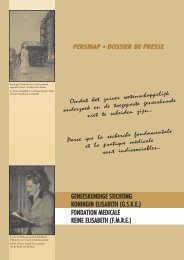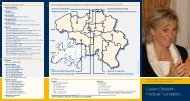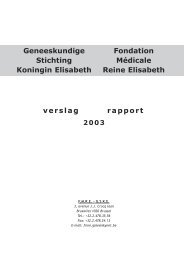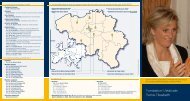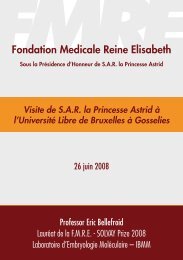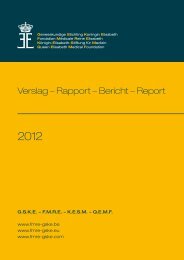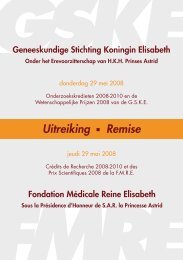Geneeskundige Stichting Koningin Elisabeth ... - GSKE - FMRE
Geneeskundige Stichting Koningin Elisabeth ... - GSKE - FMRE
Geneeskundige Stichting Koningin Elisabeth ... - GSKE - FMRE
You also want an ePaper? Increase the reach of your titles
YUMPU automatically turns print PDFs into web optimized ePapers that Google loves.
Spinal Cord Traumatic Lesion<br />
Martin, D. 1 , Maquet, V. 2 , Scholtes, F. 1 , Schoenen, J. 3 and Moonen, G. 1<br />
1 Centre de Neurobiologie Cellulaire et Moléculaire, Université de Liège, Belgique<br />
2 Service de chimie des matériaux, Université de Liège<br />
3 Centre de Neurobiologie Cellulaire et Moléculaire, Service de Neuroanatomie Université de<br />
Liège, Belgique<br />
The great diversity of the spinal cord lesions observed in human beings does not find his<br />
correspondence in the experimental models intended to study them. Some models, such as<br />
medullary section, kinetic compressions with the traditionnal technique of the released weight<br />
or the photochemical lesions aimed to study particular aspects of the lesion and regeneration<br />
of the injured spinal cord, are imitating only one particular aspect of the human situation. That’s<br />
the reason why we described first another model of acute compression of spinal cord, who uses<br />
a inflatable small balloon introduced into space under-dural in the adult rat and which, contrary<br />
to the models classically used, allows to induce a medullary contusion in a closed space. The<br />
modulation of the physical parameters of compression (volume of inflation, duration of compression)<br />
can modify in a reproducible way the importance of the medullary contusion and can<br />
be correlated with behavioral deteriorations which result from it. The detailed study of the evolution<br />
of the lesion during the first four weeks following the lesion enabled us to show the massive<br />
but transitory regeneration of axons originating from telencephalic regions in the injured<br />
CNS. It is associated with the invasion of the lesion by a heterogeneous cellular population<br />
made up of macrophages, endothelial cells and especially<br />
Schwann cells which are organized in a screen directed in the large axis of the spinal cord.<br />
Moreover, we developed various techniques of repair of the damaged spinal cord. In particular,<br />
we used various cellular types for grafting with the aim to modify the injured site and to bring<br />
elements favorable to its rebuilding. As we showed, there is an important axonal regeneration in<br />
the injured CNS but it is only transitory and disappear gradually. In our approach of transplantation,<br />
we systematically used cells coming from adult syngenic animals in order to place us from<br />
the clinical point of view for autograft Schwann cells constitute a particularly interesting cellular<br />
stock since they sustain a effective axonal regenetion in the PNS. In the spinal cord lesion induced<br />
in our model using the inflatable small balloon, the grafted Schwann cells are quickly integrated.<br />
They limit post-traumatic cavitation and the gliosis. They favor a massive axonal regrowth,<br />
but the immunohistochimic characterization of fibres demonstrate a local origin starting from the<br />
adjacent spinal ganglia with the lesion rather than a telencephalic source. By allowing the axonal<br />
growth within the injured CNS, the grafted Schwann cells “peripheralize” the injured spinal cord.<br />
In order to favor the fast elimination of the myelin debris which accumulate in the lesion,<br />
we carried out transplantations of peritoneal macrophages. They are able to be integrated in<br />
the spinal cord and to reduce the cystic cavitation and do not induce an important gliosis. To<br />
a lesser degree than Schwann cells, they are able to support the axonal regrowth coming from<br />
spinal ganglia. If they contribute, by reducing the myelin debris accumulated in the lesion, “ to<br />
decentralize “ the CNS, they support also the migration of Schwann cells from the adjacent dorsal<br />
roots and by ths way, stimulate te axonal regrowth from spinal ganglia.<br />
137


